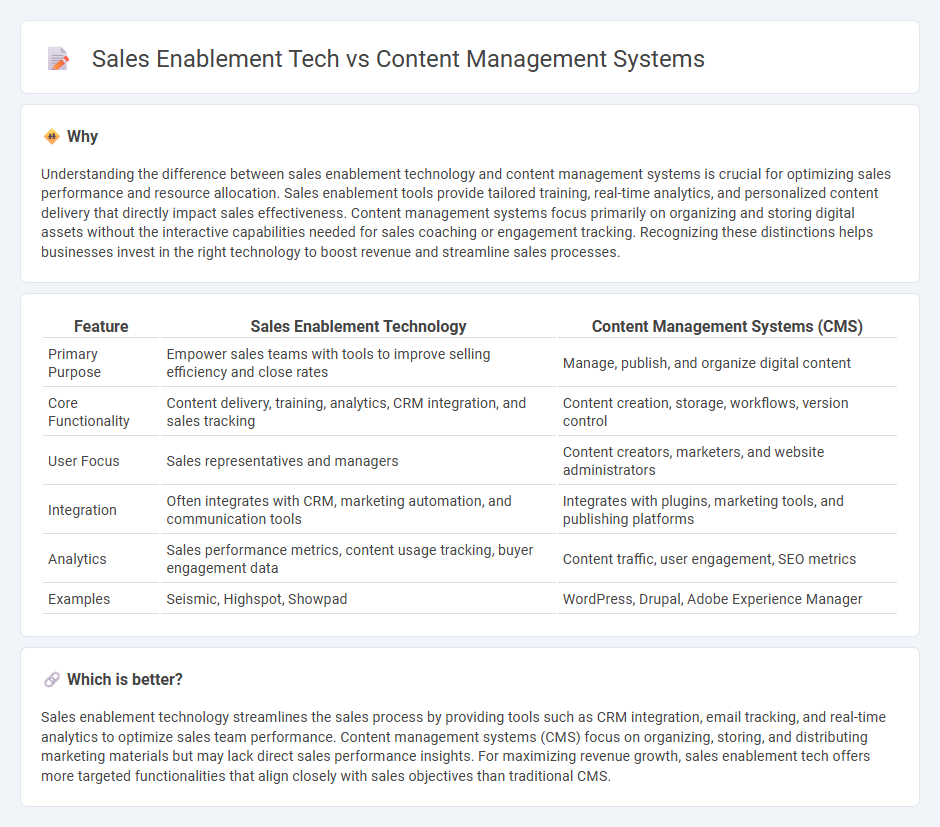
Sales enablement technology streamlines the sales process by providing tools that deliver targeted content, training, and analytics to sales teams, enhancing their ability to engage prospects effectively. Content management systems (CMS) focus on organizing, storing, and distributing marketing materials, but lack the interactive and analytics-driven features essential for optimizing sales performance. Discover how integrating sales enablement tech can transform your sales strategy and boost revenue growth.
Why it is important
Understanding the difference between sales enablement technology and content management systems is crucial for optimizing sales performance and resource allocation. Sales enablement tools provide tailored training, real-time analytics, and personalized content delivery that directly impact sales effectiveness. Content management systems focus primarily on organizing and storing digital assets without the interactive capabilities needed for sales coaching or engagement tracking. Recognizing these distinctions helps businesses invest in the right technology to boost revenue and streamline sales processes.
Comparison Table
| Feature | Sales Enablement Technology | Content Management Systems (CMS) |
|---|---|---|
| Primary Purpose | Empower sales teams with tools to improve selling efficiency and close rates | Manage, publish, and organize digital content |
| Core Functionality | Content delivery, training, analytics, CRM integration, and sales tracking | Content creation, storage, workflows, version control |
| User Focus | Sales representatives and managers | Content creators, marketers, and website administrators |
| Integration | Often integrates with CRM, marketing automation, and communication tools | Integrates with plugins, marketing tools, and publishing platforms |
| Analytics | Sales performance metrics, content usage tracking, buyer engagement data | Content traffic, user engagement, SEO metrics |
| Examples | Seismic, Highspot, Showpad | WordPress, Drupal, Adobe Experience Manager |
Which is better?
Sales enablement technology streamlines the sales process by providing tools such as CRM integration, email tracking, and real-time analytics to optimize sales team performance. Content management systems (CMS) focus on organizing, storing, and distributing marketing materials but may lack direct sales performance insights. For maximizing revenue growth, sales enablement tech offers more targeted functionalities that align closely with sales objectives than traditional CMS.
Connection
Sales enablement technology integrates seamlessly with content management systems to streamline the distribution and tracking of sales collateral. These platforms centralize marketing materials, enabling sales teams to access up-to-date content that enhances customer engagement and accelerates the sales cycle. Leveraging analytics from both systems provides insights into content effectiveness, driving data-informed strategies that boost revenue growth.
Key Terms
Centralized Repository
Content management systems (CMS) excel at providing a centralized repository that organizes, stores, and manages digital content across various formats for easy access and governance. Sales enablement technology integrates this centralized repository with tools designed to deliver relevant content and training to sales teams, enhancing their efficiency and customer engagement. Explore how these platforms optimize content accessibility and sales performance by learning more about their centralized repository capabilities.
Sales Playbooks
Sales playbooks integrated within sales enablement technology provide sales teams with dynamic, data-driven guidance tailored to customer interactions, elevating deal effectiveness and pipeline velocity. In contrast, content management systems primarily organize and store sales assets without offering real-time insights or contextual recommendations. Explore how leveraging sales enablement platforms can transform your sales strategy by delivering actionable playbooks.
Content Analytics
Content management systems (CMS) provide robust tools for organizing, storing, and distributing digital content across platforms, emphasizing content creation and management workflows. Sales enablement technologies integrate content analytics to track content performance in real-time, offering insights into how sales teams and prospects engage with materials, thereby optimizing sales strategies. Explore the differences in depth to understand which solution maximizes your content's impact and drives revenue growth.
Source and External Links
What is a content management system (CMS)? - Optimizely - A CMS is software that enables users to create, manage, and modify digital content without needing coding skills, featuring collaborative tools, content delivery, and integration with other marketing systems.
What Is A Content Management System (CMS)? - Oracle - A CMS provides a centralized platform for teams to create, edit, organize, and publish digital content easily through an interface, with role-based permissions and automated collaborative workflows.
Content management system - Wikipedia - A CMS is software used for the creation and modification of digital content, typically consisting of a content management application (front-end) and a content delivery application (back-end), with options for on-premises or cloud-based installation.
 dowidth.com
dowidth.com